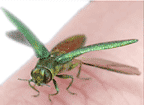Way Downstream
In time for the Fourth of July, America’s big bird makes an official comeback. The Fish and Wildlife Service just announced that bald eagles have regained such abundance that they can be crossed off the endangered species list. Strong protections from the Endangered Species Act brought eagles back to all lower 48 states and our capital. Bald eagles claim a beat-the-odds success story: In the middle of the 20th century, only a few hundred pairs lived in the U.S. due to hunting, poisoning, habitat destruction and the pesticide DDT. Today, over 11,000 pairs thrive around the country …

In woods around America, we have an itching, burning reason beyond global warming to curb carbon dioxide emissions. Two new studies — by Duke University and the U.S. Department of Agriculture’s Agriculture Research Center at Beltsville — find higher levels of carbon dioxide cause poison ivy to flourish more rapidly and with more toxicity then ever before. Inflated CO2 levels intensified urushiol: poison ivy’s poison. Besides inflicting 80 percent of us with itchy rashes, poison ivy kills trees and slows forest regeneration …
Statewide, fewer kids have lead coursing through their veins. Of 102,974 children under six tested in 2006, 1,274 children — 1.2 percent — had an elevated blood lead level, according to the Childhood Lead Registry. That’s less than the 1.3 percent of 99,148 kids tested in 2005. Baltimore City children fared worse both years: 4.6 percent tested positive for lead in 2006; down from 4.8 percent in 2005. Lead poisoning, a preventable disease, often links to poor school performance, inability to read, aggressive behavior, hearing loss or mental retardation: www.mde.state.md.us/Programs/LandPrograms/LeadCoordination/index.asp …
From ocean to mountains, preserving Maryland costs mega-bucks. Keeping his promise to spend Program Open Space and Rural Legacy money where it belongs, Gov. Martin O’Malley and the Board of Public approved $92,665,138 in fiscal year 2007, funding 231 local projects and preserving 1,446 acres. Next year, O’Malley promises $289 million for land preservation and $138 million to improve local water and wastewater systems.
FY ’07’s last Open Space project spent $4.6 million in Queen Anne’s County for the 270-acre Kudner Property, for wetlands and woodland wildlife habitat, plus recreation and teaching. For Rural Legacy projects in Baltimore, Charles and Worchester counties $125,000 was approved for conservation easements …

Our Creature Feature comes to us from the U.S. Senate, where a new senatorial caucus has been born from the invasion of the rapacious Emerald Ash Borer. Senators from four invaded states — Dick Durbin and Barack Obama from Illinois; Carl Levin and Debbie Stabenow from Michigan; Maryland’s Ben Cardin; and Sherrod Brown from Ohio — are asking for federal money to help local governments bear the cost of surveying trees for the half-inch winged pest, removing and replacing infested trees. Proposed by Durbin, the Emerald Ash Borer Municipality Assistance Act of 2007 will create a low-interest revolving loan fund …
